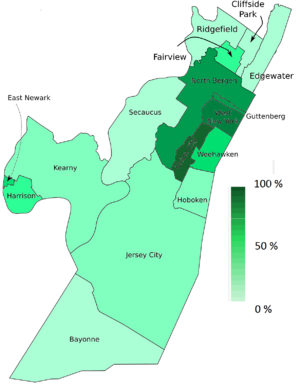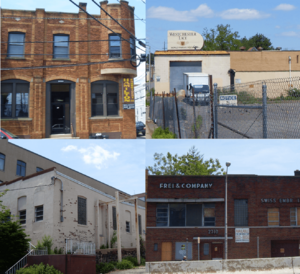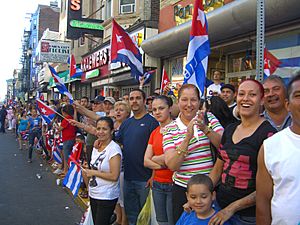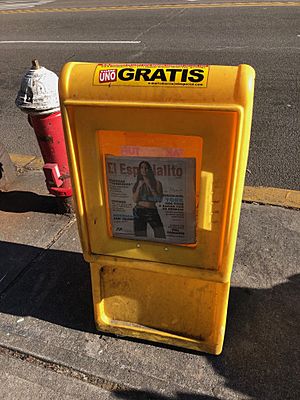Havana on the Hudson facts for kids
Havana on the Hudson is a special nickname for the northern part of Hudson County, in the U.S. state of New Jersey. This name comes from Havana, the capital city of Cuba, and because this part of Hudson County is very close to the Hudson River.
In the second half of the 1900s, many Cubans left their home country. They moved to places like Union City, West New York, and nearby towns. They were looking for better jobs and political freedom. Cuban culture became very strong in this area. Over time, many Cubans moved to other towns. Also, many other Hispanic groups came to live there. This made the area a vibrant mix of different Latino cultures, businesses, and identities. Even with this mix, Cubans are still a powerful group in local elections. Many towns along the Hudson Palisades in northern Hudson and southeast Bergen counties have populations where more than half of the people were born in other countries. Often, most of these residents are Hispanic. Some of these towns are among the most crowded in the U.S.. Guttenberg, Union City, and West New York are the top three most crowded towns in New Jersey.
Contents
History of Cuban Influence
Before the Cuban Revolution in 1959, about 150,000 Cubans lived in the United States. Most were in New York City and in Key West and Tampa, Florida. A small group of about 2,000 Cubans lived in Union City. They had arrived after the 1940s, many from the Villa Clara area in Cuba.
In the early 1900s, North Hudson grew a lot and became known as the Embroidery Capital of America. This was because of the embroidery and other textile industries started by German-speaking immigrants. Later, people from Ireland, Slavic countries, Jewish communities, the Middle East, and Italy also moved there. By the 1960s, North Hudson was changing. Many people were moving to the suburbs. The population was getting smaller. But the arrival of new residents, especially Cubans, helped the area avoid a bigger decline.
Cuban Immigration to New Jersey
First Arrivals
In the second half of the 1900s, hundreds of thousands of Cubans from all walks of life moved to the United States. Right after the Cuban Revolution, many wealthy professionals and people connected to the old government left Cuba. They were afraid of what the new government might do. By 1962, when flights between the two countries stopped, 200,000 Cubans had already moved. Another 300,000 left when some flights restarted from Cuba's Varadero Beach between 1965 and 1973.
The first stop for many of these Cubans was Miami, Florida, which is close to Cuba. Many hoped they would soon return home if Castro's government was overthrown. But that day never came.
Many Cubans chose Hudson County because it was close to New York. It offered job opportunities, family connections, and a chance to buy homes and rebuild their close-knit communities. As they moved in, they could buy homes and businesses from people who were moving to the suburbs. Hudson County quickly became a main center for Cuban American culture. Union City had many jobs in the embroidery industry. By 2006, Hudson County was the heart of New Jersey's Cuban community, which had about 100,000 people.
Freedom Flights
After the Cuban Missile Crisis in 1962, President John F. Kennedy put limits on travel to Cuba. The U.S. also froze Cuban assets and put an embargo (a ban on trade) on Cuba. This was because Cuba was hosting Soviet nuclear weapons.
People who wanted to leave Cuba were seen as refugees. They were offered special resident status in a U.S.-supported program called Freedom Flights (1965–1974). These flights helped Cubans move to the U.S. They could not take any money or personal items with them. So, this was mainly possible for those who had friends, family, or sponsors in the United States. Children born in the USA automatically became U.S. citizens.
Changes in Immigration Laws
The Immigration and Nationality Act of 1965 changed old immigration rules. It allowed more people from non-European countries to come to the U.S. This changed the ethnic makeup of the United States. Immigration doubled between 1965 and 1970, and again between 1970 and 1990. The biggest change was that more immigrants came from Asia and Central and South America, rather than Europe. Experts say these changes in immigration laws were a big reason for the increase of Hispanic immigrants in Hudson County.
Mariel Boatlift
The Mariel boatlift was a large movement of Cubans who left Cuba's Mariel Harbor for the United States. This happened between April and October 1980. Some of these refugees traveled on makeshift boats and rafts. The Coast Guard rescued them, and some eventually made it to North Hudson. Later, in 1994, the U.S. and Cuban governments agreed on a system. The U.S. would give at least 20,000 visas each year. In return, Cuba promised to stop people from leaving illegally on rafts.
Politics and Cuban Americans
Views on Cuba
For many years, especially among older Cuban exiles, there was strong support for the United States embargo against Cuba (also called el bloqueo, or "the blockade"). They did not want the U.S. to have normal relations with the Cuban government. Even today, there is still some resistance to normalizing relations with Cuba. For example, in 2009, a band that had played in a peace concert in Havana was removed from a performance at Union City High School. Rallies against normalizing relations are still held.
While Cuban Americans are not the largest Hispanic group in New Jersey, they are seen as very successful in politics. This is because they often vote together and pay close attention to issues about Cuba–United States relations. These issues include policies like "wet feet, dry feet" or the Elián González custody dispute in 2000. This unity is often seen in groups who moved for political reasons, more than those who moved for economic reasons. While Cubans in Florida often vote for Republican candidates, those in New Jersey mostly vote Democrat. This makes them an important voting group in New Jersey.
One famous politician from this community is Bob Menendez. He started his political career with Union City Mayor William Musto. After Menendez spoke out against Musto, who was found guilty of corruption, Menendez became mayor himself. He was known for his modern views on social issues and strong opposition to Castro.
The Cuban Democracy Act was a law passed in 1992. It was proposed by U.S. Congressman Robert Torricelli from New Jersey. This law stopped foreign companies connected to U.S. companies from trading with Cuba. It also limited travel to Cuba by U.S. citizens and sending money to families there. The law aimed to encourage a peaceful change to democracy in Cuba by putting sanctions on the Castro government. It stated that the Castro government did not respect human rights or democratic values.
The Helms-Burton Act (1996) further limited interactions with Cuba. However, later changes allowed presidents to waive parts of the law. In April 2009, President Barack Obama lifted the ban on travel and sending money and medicine to Cuba.
Changing Views
Over time, support for the embargo has changed, especially among the children of Cuban exiles. Younger generations often have different opinions than their parents or grandparents who first immigrated.
Cultural Impact
Public Officials
To vote and hold public office in the United States, a person must be a U.S. citizen. The lower Hudson Palisades area has many foreign-born residents. Still, several politicians of Latin American background, some born abroad and some born locally, have been elected to office. William Musto, who was mayor of Union City for two terms, was known for hiring and promoting Hispanic residents. He also pushed for bilingual education.
Here are some notable public officials from the Latino community:
- Marlene Caride
- Zulima Farber, judge
- Rudy Garcia
- Bob Menendez, United States Senator
- Vincent Prieto, State Assemblyman
- Ruben J. Ramos, State Assemblyman
- Eliu Rivera, Freeholder
- Caridad Rodriguez, State Assemblywoman
- Felix Roque, Mayor of West New York
- Esther Salas, federal judge
- Albio Sires, Member of the United States House of Representatives
- Anthony R. Suarez, former Mayor of Ridgefield, New Jersey
- Silverio Vega, Mayor of West New York
Street Life
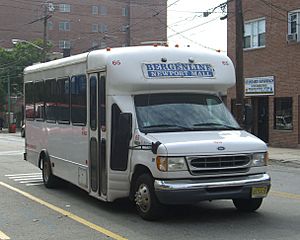
The Latino presence along the Hudson River is very clear on Bergenline Avenue. This street runs for 90 blocks through North Hudson and continues north into Fairview. Along this street, many private minibuses, called guaguas (in some Caribbean countries), offer rides to places in Jersey City and Manhattan.
Summit Avenue near the Transfer Station also has many Latino businesses. Parts of Palisade Avenue in Jersey City Heights are similar. Marin Boulevard in Downtown Jersey City was named after Luis Muñoz Marín to honor the large Puerto Rican population there. In North Hudson, signs and language are often bilingual (in both English and Spanish). While you can see many chain stores, there are also many family-run businesses and small local shops. Corner stores and bodegas (small grocery stores) often sell Goya Foods, the largest Hispanic-owned food company in the U.S., which is based nearby in Secaucus.
The area offers many different Latin American foods. These include Cuban, Ecuadorian, Puerto Rican, and Mexican dishes. You can find popular Latino foods like tostones (fried plantains), ropa vieja (shredded beef), and batidos (fruit shakes) on local menus. You can also find traditional Cuban cigars made locally.
Annual Events
The Cuban Day Parade of New Jersey started around the year 2000. It marches south along Bergenline Avenue in North Hudson County. It has become a big part of large celebrations held at Scheutzen Park and Celia Cruz Park. Celia Cruz Park is home to the "Walk of Fame". This walk honors famous musicians and singers. It was dedicated to the late salsa singer Celia Cruz in 2004. It now includes marble stars honoring artists like Tito Puente, Johnny Pacheco, Israel "Cachao" Lopez, Beny Moré, La India, and news anchor Rafael Pineda.
Three Kings Day, an important holiday in the Hispanic community, has been celebrated there every year since the 1980s. The city of Bayonne, NJ also has an annual Hispanic Day Parade that marches through a large Latino section of the city.
Media
El Especial and El Especialito are Spanish-language weekly newspapers. They are for readers in New Jersey, New York City, and Miami. As of 2016, they are based in Union City and have a circulation of about 230,000 in the New York metropolitan area. Before it closed in 1991, the Hudson Dispatch included pages in Spanish, as did the Jersey Journal. Since May 2010, a free bilingual newspaper called Hudson Dispatch Weekly has served the North Hudson area. It is printed by the Evening Journal Association. One side is in English, and the other is in Spanish, called la comunidad. The Brooklyn-based daily newspaper, El Diario La Prensa, is widely available.
The Spanish Broadcasting System was started in Newark, New Jersey in 1983. It operates WPAT, a radio station licensed to Paterson. Univision's WFUT and Telefutura's WXTV are two TV stations that share a market in the New York metropolitan area. They are licensed to and have their studios in northeastern New Jersey. WNJU, the main station of the Spanish-language Telemundo TV network, is licensed to Linden and has its studios and offices in Fort Lee.
Arts and Education
North Hudson is sometimes called NoHu in the visual arts world. Many visual and performing artists and producers with Latino backgrounds are from or live in this region. They include:
- Bobby Cannavale (born 1971), actor known for his roles on Ally McBeal, Third Watch, and Will & Grace.
- Joey Diaz, comedian and actor
- Paquito D'Rivera, a jazz musician and writer who has won nine Grammy Awards
- Henry Escalante, a pop musician and finalist from the 2007 MTV show Making Menudo.
- Lucio Fernandez, Union City Commissioner of Public Affairs, who is also an author, artist, actor, singer, and dancer
- Ada Ferrer (1963), historian, writer, professor
- Melissa Fumero, actress
- Erick Morillo (1971–2020), DJ and music producer
- Luis Moro (born 1964), actor, filmmaker, writer.
- Oscar Nunez, screenwriter/actor
- Carol-Lynn Parente, executive producer of Sesame Street
- Franck de Las Mercedes, folklore artist
- Caitlin Sanchez, actress
See also
- Cuban Americans
- Hispanics and Latinos in New Jersey
- Alvaro de Molina
- Ironbound, a Portuguese and Brazilian area in Newark
- Little Havana, Miami, Florida, a similar Cuban area in Miami
- India Square, an Indian area in Jersey City
- Five Corners, a Filipino shopping district in Jersey City
- La Ventiuno, Paterson
- Little Lima
- Koreatown, Palisades Park, a Korean area in southeast Bergen County
- Hudson Waterfront, sometimes called Gold Coast (New Jersey)
- Gateway Region, a name for northeastern New Jersey


